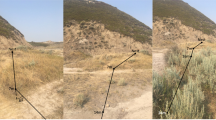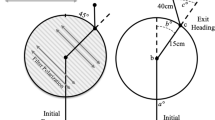Summary
The topographic orientation of two species of ants is compared. Differential cue emphasis exists in diurnal orientation between the primarily nocturnalCamponotus pennsylvanicus and the mainly diurnalFormica subsericea. Field experiments demonstrated that both species use celestial and landmark cues for orientation. Although both species use visual cues and odor trails, forF. subsericea the former serve a more important role and vice versa forC. pennsylvanicus. The importance of these orientational differences is discussed in relation to the behavioral ecology of each species.
Zusammenfassung
Die Topographische Orientierung zweier Ameisen-Arten wird verglichen. Zur Orientierung während des Tages verwenden die hauptsächlich nachts-aktive Art,Camponotus pennsylvanicus, und die hauptsächlich tags-aktive Art,Formica subsericae, verschiedene Eigenschaften der Umwelt. Untersuchungen im Freiland zeigen, dass beide Arten Himmels-und Grezstein-Orientierung besitzen. Obwohl beide Arten auf visuelle Eigenschaften bzw. Duftspuren reagieren, spielen beiF. subsericea die ersterwähnten eine wichtigere Rolle; und beiC. pennsylvanicus ist es umgekehrt. Diese Orientierungsunterschiede werden mit Bezug auf die Verhaltensökologie der beiden Arten diskutiert.
Similar content being viewed by others
References
Barlin M., Blum M., Brand J., 1976. — Species-specificity studies on the trail pheromone of the carpenter ant,Camponotus pennsylvanicus (Hymenoptera: Formicidae).J. Georgia Ent. Soc., 11, 162–164.
Blum M., Wilson E., 1964. — The anatomical source of trail substances in formicine ants.Psyche, 71, 28–31.
Bonnet C., 1779. — Observation XLIII. Sur un procédé des fourmis.Œuvres d'Histoire Naturelle et de Philosophie, 1, 535–536.
Campan R., 1978. — L'utilisation des repères visuels terrestres dans l'orientation des insectes.L'Année Biologique, 17, 61–90.
David C., Wood D., 1980. — Orientation to trails by a carpenter ant,Camponotus modoc (Hymenoptera: Formicidae), in a giant sequoia forest.Can. Ent., 112, 993–1000.
Gould J., 1986. — The locale map, of honey bees: do insects have cognitive maps?Science, 232, 861–863.
Hartwick E., Friend W., Atwood C., 1977. — Trail-laying behaviour of the carpenter ant,Camponotus pennsylvanicus (Hymenoptera: Formicidae).Can. Ent., 109, 129–136.
Hölldobler B., 1971. — Homing in the harvester antPogonomyrmex badius.Science, 171, 1149–1151.
Hölldobler B., 1976. — Recruitment behavior, home range orientation and territoriality in harvester ants,Pogonomyrmex.Behav. Ecol. Sociobiol., 1, 3–44.
Hölldobler B., 1978. — Ethological aspects of chemical communication in ants.Adv. Study Behav., 8, 75–115.
Hölldobler B., 1980. — Canopy orientation: a new kind of orientation in ants.Science, 210, 86–88.
Hölldobler B., Moglich M., 1980. — The foraging system ofPheidole militicida (Hymenoptera: Formicidae).Insect. Soc., 27, 237–264.
Hölldobler B., Wilson E., 1978. — The multiple recruitment systems of the African weaver antOecophylla longinoda (Latreille) (Hymenoptera: Formicidae).Behav. Ecol. Sociobiol., 3, 19–60.
Jander R., 1957. — Die optische Richtungsorientierung der Roten Waldameise (Formica rufa L)Z. vergl. Physiol., 40, 162–238.
Jander R., 1977. — Orientation ecology. In:Encyclopedia of Ethology. Ed. by B. Grzimek, 145–163. Van Nostrand Reinold Co, New York.
Jander R., Jander U., 1979. — An exact field test for the fade-out, time of the odor trails of the Asian Weaver antsOecophylla smaragdina.Insect. Soc., 26, 165–169.
Klotz J., 1984. — Diel differences of foraging in two ant species (Hymenoptera: Formicidae).J. Kansas Ent. Soc., 57, 111–118.
Klotz J., Cole S., Kuhns H., 1985. — Crest-line orientation inCamponotus pennsylvanicus (DeGeer).Insect. Soc., 32, 305–312.
Rosengren R., 1971. — Route fidelity, visual memory and recruitment behaviour in foraging wood ants of the genusFormica (Hymenoptera, Formicidae).Acta Zool. Fenn., 133 1–106.
Santschi F., 1911. — Observations et remarques critiques sur le mécanisme de l'orientation chez les fourmis.Rev. Suisse Zool., 19, 303–338.
Traniello J., 1977. — Recruitment behavior, orientation, and the organization of foraging in the carpenter antCamponotus pennsylvanicus DeGeer (Hymenoptera: Formicidae).Behav. Ecol. Sociobiol., 2, 61–79.
Wehner R., 1981. — Spatial vision in arthropods. In:Handbook of Sensory Physiology, Ed. by H. Autrum, 287–616. Springer-Verlag, New York.
Wehner R., 1982. — The bee's celestial map — a simplified model of the outside world. In:The Biology of Social Insects. Ed. by M. Breed, C. Michener, H. Evans, 375–379. Westview, Boulder, Colorado.
Wehner R., 1982. — Himmelsnavigation bei Insekten, Neurophysiologie und Verhalten.Neujahrsbl. Naturforsch. Ges. Zurich,184, 1–132.
Wehner R., 1983. — Celestial and terrestrial navigation: human strategies-insect strategies. In:Neuroethology and Behavioral Physiology, Roots and Growing Points. Ed. by F. Huber, H. Markl, 366–381. Springer-Verlag, Berlin Heidelberg, New York, Tokyo.
Wehner R., Flati I., 1972. — The visual orientation of desert ants,Cataglyphis bicolor, by means of terrestrial cues. In:Information Processing in the Visual Systems of Arthropods. Ed by R. Wehner, 295–302. Springer-Verlag, New York.
Wehner R., Lanfranconi B., 1981. — What do the ants know about the rotation of the sky?Nature, 293, 731–733.
Wehner R., Menzel R., 1969. — Homing in the antCataglyphis bicolor.Science, 164, 192–194.
Wehner R., Raber F., 1979. — Visual spatial memory in desert ants,Cataglyphis bicolor (Hymenoptera: Formicidae).Experientia, 35, 1569–1571.
Wilson E., 1962. — Chemical communication among workers of the fire antSolenopsis saevissima (Fr. Smith) I. The organization of mass-foraging.Anim. Behav., 10, 134–147.
Author information
Authors and Affiliations
Rights and permissions
About this article
Cite this article
Klotz, J.H. Topographic orientation in two species of ants (Hymenoptera: Formicidae). Ins. Soc 34, 236–251 (1987). https://doi.org/10.1007/BF02224356
Received:
Accepted:
Issue Date:
DOI: https://doi.org/10.1007/BF02224356




